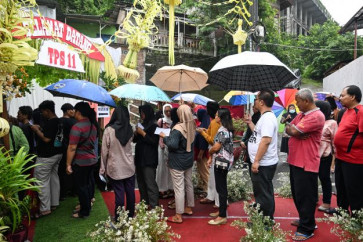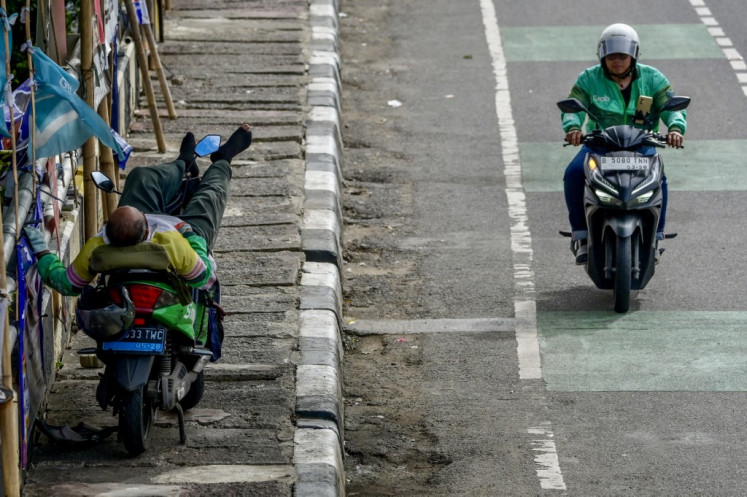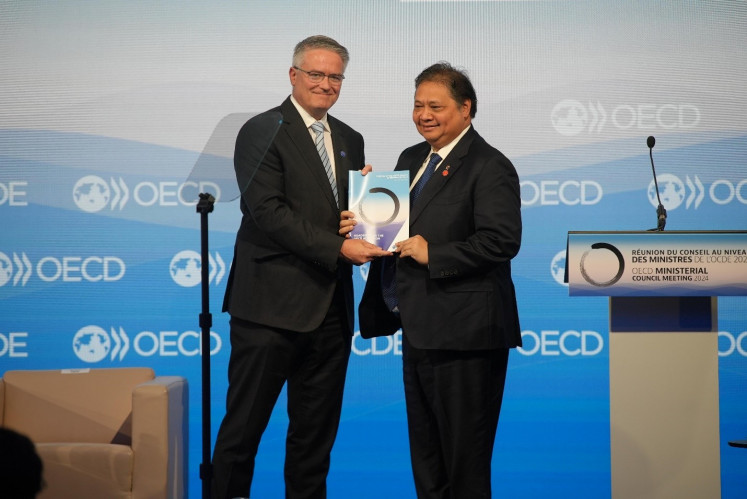Free trade agreement not a threat: Local artisans
Sarinah, 54, painstakingly applied her canting (a pen-like tool to draw the batik pattern in wax) across a piece of fabric decorated with a batik motif in wax
Change Size

S
arinah, 54, painstakingly applied her canting (a pen-like tool to draw the batik pattern in wax) across a piece of fabric decorated with a batik motif in wax.
Occasionally, she would blow on the canting before it touched the cloth.
Sticking to tradition: Three women stir batik dye from the same pan. Hundreds of women in the area make a living out of designing batik tulis (using a canting rather than a metal stamp). JP/Agus Maryono
Blowing on the canting is necessary so the material isn’t damaged by the hot wax it contains, said
Sarinah.
Sarinah, a resident of Maos Kidul village in Cilacap, Central Java, is one of hundreds of women who work as batik artists. Some of them create batik in their homes while others work at their employer’s house.
However, only 10 percent use their skills to create their own batik designs. The rest work for someone else, and are paid on the quantity of batik they produce.
Tonik Sudarmaji, 40, owns Rajamas Batik, one of the batik businesses in the village of Maos Kidul. He employs 70 women in his workshop, all are over 50 years of age.
“The art of creating batik has been handed down from generation to generation for hundreds of years
in this area … The history of batik tulis here is part of the cultural heritage of Prince Diponegoro, dating back to the 1800s,” Tonik told The Jakarta Post at his workshop recently.
“According to this story, this village is one of the places Prince Diponegoro rested when he fought in this region, along with his soldiers. The soldiers planned their war strategies and recorded them in the form of a special Maos batik,” Tonik said.
He later explained that Maos batik was a special type of hand-drawn batik (batik tulis) with a very special design only found in this part of Indonesia.
“What makes Maos batik unique is a classic motif with a dark base, a combination of a white and red tree bark colors, or dark brown,” Tonik said.
The names of the batik motifs are derived from the Prince Diponegoro’s war strategies, Tonik said.
“The special Maos batik motifs have unique names such as Cebong Kumpul, Kembang Ambring and Lung Seketi. All these names were part of the warrior code, which was composed as part of a strategy to defeat the enemy,” Tonik said.
Maos batik tulis is mainly sold to middle-to-upper-class clients, because it is fairly expensive to produce. The cheapest men’s shirt, for example, retails for around Rp 350,000 (US$40).
Prices can also reach tens of millions of rupiah for batik traced on silk. This type of batik is expensive because the manufacturing process is complicated and takes quite a long time, Tonik said.
“Almost all our important officials including the First Lady have special Maos batik tulis. They usually buy it when I hold an exhibition in Jakarta,” Tonik said.
Tonik added that he welcomed good free market relations in the ASEAN-China Free Trade Area (ACFTA) agreement, which has come into effect this year. With the agreement, the market for batik tulis is expected to grow in several neighboring countries in Asia, without difficult trade procedures.
“We are very pleased with the free market agreement. We aren’t afraid at all of ACFTA. In this era, this is a golden opportunity for us to expand overseas,” said Tonik, who is also the chairman of the Central Java Warna Alam Batik Tulis Craft Workers’ Forum.
“Batik tulis products aren’t produced by China. China makes cheap batik cap [batik made using metal stamps].
So, it would be impossible for China to make the same product at a cheaper price,” said Tonik, who is also the owner of Rajamas Batik Tulis Maos.
Tonik said that before the free trade agreement, his batik products were mainly marketed to a number of big cities including Jakarta, Denpasar and Bandung.
“There are a number of important state officials who like Maos batik. This includes President Susilo Bambang Yudhoyono. We received an award from him because of this batik,” said Tonik, who works with his wife, Euis Rohaini.
“Since the implementation of the FTA we’ve opened an outlet in Malaysia, and next we will open one in Singapore,” Tonik said.
Thousands of pieces of special Maos batik tulis are produced by women in Maos every week, Tonik said.
“More than 100 pieces are produced in our workshop every week,” Tonik said.
Meanwhile, Maos subdistrict chief Agus Utomo said Maos batik tulis was much more attractive to consumers outside Cilacap because it was comparatively expensive.
“Yes, the lower classes can’t afford it. So it is good that it is marketed overseas,” said Agus Utomo when talking to the Post.
Agus said the Cilacap regional administration had already passed a number of decrees to help promote Maos batik.
“Every Thursday all local government officials in the Cilacap Regional Administration must wear a batik uniform purchased from Maos.
“As well as this, other ministries including the National Education Ministry have started to follow suit,” Agus said.
“We are proud of this home industry and the heritage of our ancestors,” he said.
To improve productivity, a number of craftspeople creating Maos special batik tulis have said they require bigger workshops. At the moment they work with “a limited set of tools in their kitchens”.
“So this is exactly our problem at the moment. We don’t have adequate workshops. Batik here is a home industry, often conducted by women in their kitchens.
“We still lack workshops, especially for the finishing processes and coloring,” he said. Among the hundreds of home industries making Maos batik, all carry out the finishing process in a very simple way using laundry buckets in their kitchens.
“We really hope the government can help us purchase adequate equipment and facilities for us so we can increase our production,” Tonik said.
Creating special Maos batik tulis takes around ten days to complete, said Euis Rohaini, 35, the wife of Tonik Sudarmaji, who directs the women who create batik.
“The first thing is to take a piece of plain white cloth, which will be used to make the batik and draw a pattern with it. Then after that comes the canting process,” Euis said.
The canting technique consists in applying a pattern to the cloth using liquid wax.
After that, the cloth is dyed using natural colors in accordance with special characteristics of the motifs for Maos Batik.
The next process is called pelorotan, which describes the process of removing the wax from the cloth to ensure the motif can be clearly seen. This process uses hot water to wash the wax off the cloth.
“After this the cloth is dried and aired but not under direct sunlight. This drying takes around one full day,” said Euis.
“The batik cloth is then ironed and pressed until it’s smooth and ready to be marketed,” said Euis Rohaini.
Marwiyah, 56, one of the batik artists working for Euis, said batik took a long time to make and was a particularly tiring process.
“It should be done very carefully, otherwise the wax used for the batik will not melt onto the motif. And the temperature needs to be monitored to make sure it is not too hot,” Marwiyah said.
Hundreds of women in the area make a living out of creating batik tulis.









